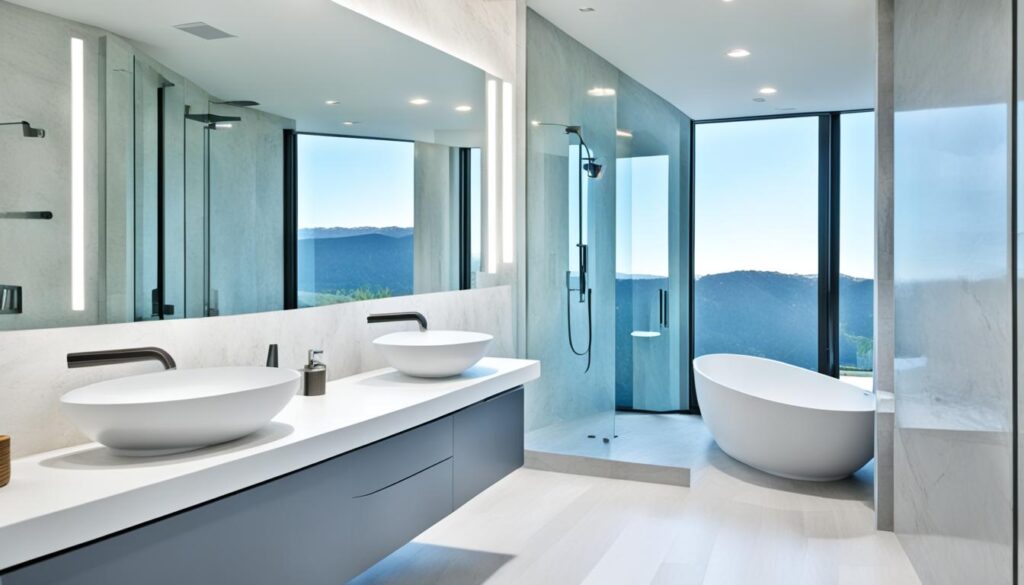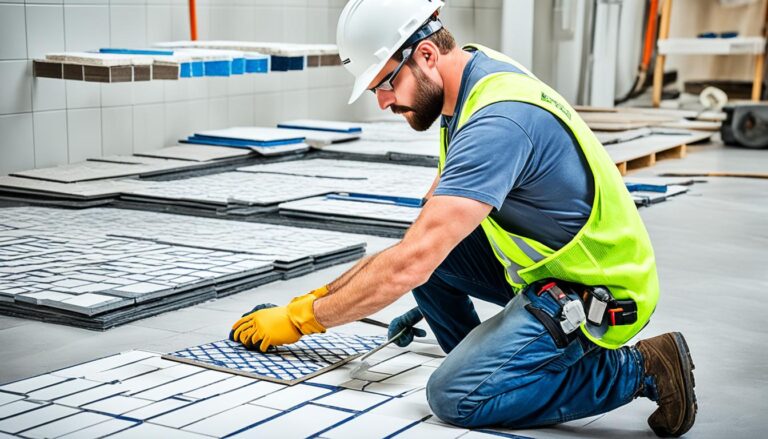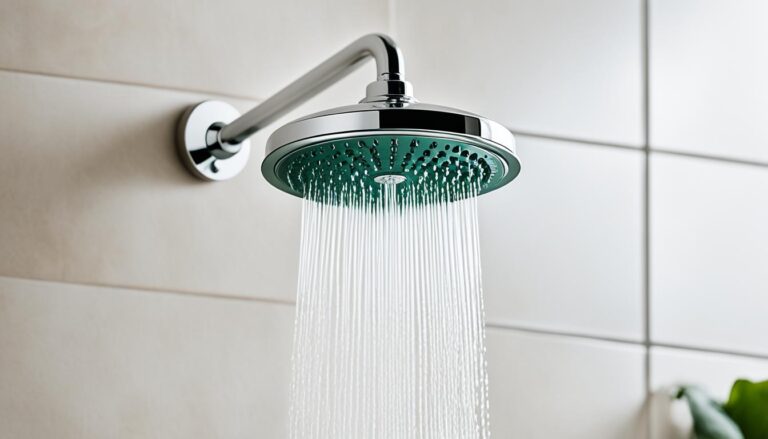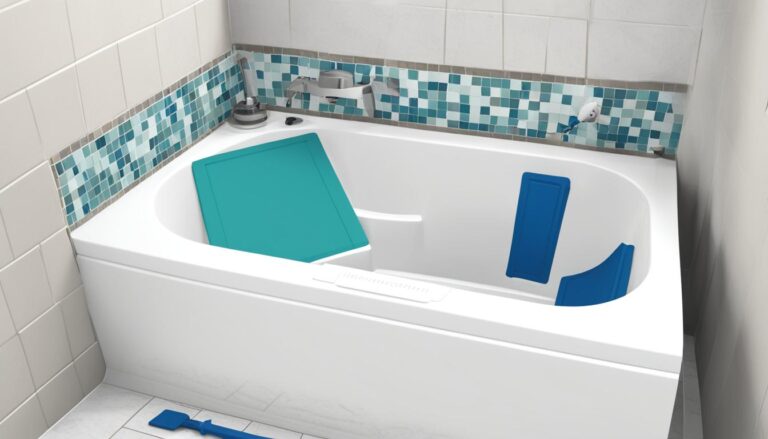Did you know the real secret to renovating your bathroom well is planning? It’s not just about looks.
This guide gives you the full scoop. It has tips and tricks from experts on bathroom renovations. You will learn how to update old features and make your bathroom work better. A smart renovation boosts your home’s value and its charm. Whether you’re redoing the whole thing or just making small changes, knowing the basics helps a lot. It’s all about making smart choices for your modern bathroom redo.
Key Takeaways
- The importance of thorough planning in bathroom renovations.
- Common reasons homeowners consider a bathroom remodel.
- How to define your objectives for a successful bathroom makeover.
- Setting a realistic budget for your home improvement projects.
- Exploring design styles and maximizing space for small bathrooms.
Understanding the Basics of Bathroom Renovation
Rethinking your bathroom’s design needs careful planning and thought. It’s not just about making it look good. It’s about creating a space that fits your lifestyle and needs. Whether you’re sprucing up an old bathroom or making room for your family, clear goals are key. They help steer your project and avoid problems later.
The Importance of Planning
When planning your bathroom redo, you have to think about your budget, style, and how long it will take. A good plan helps avoid delays and extra costs. That happens a lot in renovations. You should decide on everything from faucets to floor plans. Making smart choices early on helps a lot.
Knowing what to do first and next makes things go smoothly. You see your ideas take shape without too many hiccups. This means you can enjoy your new bathroom sooner.
Common Reasons for a Bathroom Remodel
People fix up their bathrooms for many reasons. Here are some common ones:
- Updating outdated or damaged fixtures
- Improving insufficient functionality for daily use
- Enhancing the aesthetic appeal of the home
- Addressing issues such as mold or leaks that could lead to serious damage
- Increasing property value through renovations
Knowing why you want to remodel helps keep your project on track. It ensures your new bathroom meets your needs and looks the way you want.
Assessing Your Bathroom Needs
To ensure your bathroom renovation works well, first know what you need. Start by setting clear goals that fit your everyday life. Knowing what you want from the renovation is key to all future choices.
Defining Your Objectives
Setting clear goals helps shape your renovation. Think about your main aims:
- Improving functionality
- Enhancing aesthetics
- Increasing storage space
- Boosting accessibility
By considering these goals, you can make sure the design meets your own needs and tastes.
Identifying Functional Requirements
Then, figure out what you need to change to make your bathroom work better. Look at your current bathroom and decide which changes would help most. Think about these areas:
- Storage solutions, such as cabinets or shelving
- Accessibility features, like grab bars or wider doorways
- Effective layout for easier movement
- Quality fixtures that meet daily usage demands
Knowing these needs early helps make choices that improve your daily life.
Setting a Realistic Budget for Your Bathroom Renovation
Creating a budget for your bathroom remodel is key. Money matters a lot in deciding on designs and materials. Knowing what most bathroom renovations cost can guide you. You can pick what to focus on and avoid spending too much.
Average Costs of Bathroom Renovation in the U.S.
The average bathroom remodel costs in the U.S. change a lot. They’re affected by where you live, the bathroom size, and what you plan to do. Expect to pay about $20,000 for a normal renovation. But, for a high-end update, costs can soar above $60,000. Below are some typical expenses:
| Renovation Type | Average Cost |
|---|---|
| Mid-Range | $20,000 |
| Upscale | $60,000+ |
| Basic Facelift | $10,000 |
Tips to Stay within Budget
There are smart ways to keep bathroom renovation costs down. Following these tips for budget-friendly renovations can help. Here’s how to stick to your setting bathroom renovation budget:
- Focus on must-have improvements first.
- Try refurbishing what you have instead of buying new.
- Get bids from various contractors to find the best deal.
- Choose mid-range items that are both good quality and affordable.
Choosing the Right Bathroom Design
Selecting the right bathroom design makes your space look and work better. You need to know your design style and what your bathroom requires. You might like sleek contemporary, cozy traditional, or minimal styles. Each style brings its unique flair to your renovation.
Identifying Your Design Style
Finding your design style is key to a harmonious bathroom. You may find yourself drawn to different styles:
- Modern: Known for its clean lines and simple look.
- Rustic: Features natural materials and warm, earthy tones.
- Classic: Offers timeless elegance with rich finishes and details.
Choosing a style that matches your taste can make your bathroom both welcoming and useful.
Maximizing Space for Small Bathrooms
In small bathrooms, making use of every inch is important. Employing small bathroom renovation tips can boost your experience. Strategies include:
- Floating vanities help save space and offer storage.
- Wall-mounted fixtures can make the room look bigger.
- Using recessed shelves for clever storage keeps things tidy.
These tips combine design beauty with practical use, especially in limited spaces.
| Design Style | Key Features | Best For |
|---|---|---|
| Modern | Sleek lines, minimal clutter | Contemporary homes |
| Rustic | Use of wood, earthy tones | Country or traditional styles |
| Classic | Elegant details, luxurious finishes | Timeless settings |
High-Quality Materials for Bathroom Upgrades
Picking the right materials is key for a successful bathroom makeover. Top-notch bathroom materials look great and last longer. It’s important to weigh the pros and cons of different materials.
Popular Materials and Their Benefits
Here are some top choices for bathroom remodeling:
- Natural Stone Countertops: They offer beauty and uniqueness, making your bathroom look luxurious and handle moisture well.
- Stainless Steel Fixtures: These are tough, fight against rust, and add a contemporary feel with little maintenance.
- Ceramic Tiles: Chosen for their flexibility in design, ease of cleaning, and water resistance.
Cost-Effective Alternatives
Looking for ways to save money while upgrading your bathroom? Check out these affordable options:
- Laminate Countertops: They look like natural stone but are much cheaper, offering an attractive, budget-friendly choice.
- Refinishing Existing Cabinets: This approach refreshes your space without replacing cabinets, saving both time and cash.
- Vinyl Flooring: An affordable pick that comes in different styles, it’s durable and feels good to walk on.
Knowing the differences between premium materials and budget-friendly choices helps owners decide what’s best for their needs and wallet.
| Material | Benefits | Cost-Effectiveness |
|---|---|---|
| Natural Stone Countertops | Elegant, durable, unique | Higher initial investment |
| Stainless Steel Fixtures | Modern, rust-resistant, low maintenance | Moderate pricing |
| Ceramic Tiles | Variety of designs, water-resistant | Moderate initial cost |
| Laminate Countertops | Attractive, mimics stone | Low cost |
| Refinished Cabinets | Fresh look, sustainable | Very cost-effective |
| Vinyl Flooring | Durable, comfortable, stylish | Low cost |
Hiring Professionals for Your Renovation
Finding the perfect team for your bathroom makeover is key. It’s crucial to know the difference between a general contractor and a design build remodeler. This affects how your project flows and its end result. Think about what your project needs before choosing.
Choosing Between a General Contractor and Design Build Remodeler
A general contractor oversees different parts of the job, like hiring workers, keeping schedules, and managing money. On the other hand, a design build remodeler handles both the design and building. This makes communication and the work process smoother. When picking between them, consider how complex your renovation is and if you prefer focusing on design or the building part.
Key Questions to Ask Potential Contractors
Before you pick a contractor, ask important questions. Find out about their experience, insurance, and past work. This helps you see if they’re skilled and reliable. Understanding how they work will make you feel more confident in your choice.
- What is your experience with bathroom renovations?
- Can you provide examples of previous projects?
- Do you have valid insurance and licensing?
- What is your approach to project management?
- How do you handle unexpected issues during the renovation?
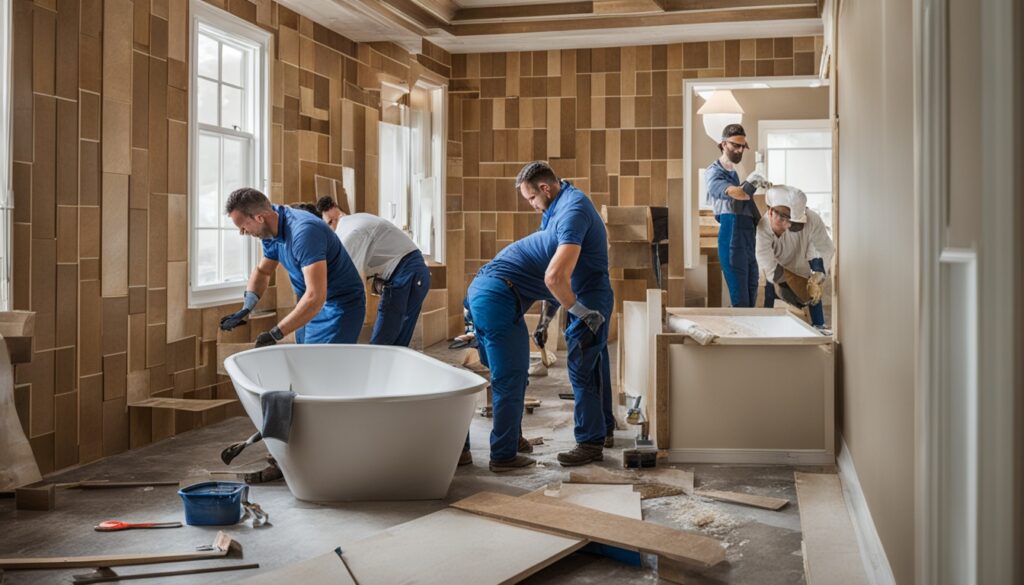
| Criteria | General Contractor | Design Build Remodeler |
|---|---|---|
| Project Management | Typically manages subcontractors and schedules | Handles both design and construction aspects |
| Communication | May require more back and forth with multiple parties | Streamlined communication with a single point of contact |
| Cost Control | May result in higher costs due to multiple bids | Single contract can provide clearer cost estimates |
| Design Flexibility | Limited flexibility, as design options depend on subcontractors | More integrative approach allows for consistent design |
Executing Your Bathroom Renovation Plan
To execute a renovation plan well, you must do the demo and prep work right. Starting with bathroom demo means turning off utilities and safely removing fixtures and fittings. Clearing out everything removable is key for a smooth transformation.
Demolition and Preparing the Space
Focus on safety and being thorough during demolition is crucial. Follow these necessary steps:
- Shut off utilities: Make sure water and electricity are off before you start removing anything.
- Remove existing fixtures: Carefully take out sinks, toilets, and bathtubs to avoid damaging plumbing and tiles.
- Clear debris: Responsibly get rid of old materials, especially heavy ones like tiles and drywall.
- Inspect underlying structures: Look for any water damage or mold before moving ahead.
Installation Checklist for New Fixtures
After demolition, you need a checklist for installing bathroom fixtures. This list helps make sure you install everything needed, step by step. Here’s a table to help you organize your installations:
| Fixture | Location | Status |
|---|---|---|
| Sinks | Vanity Area | Planned |
| Toilet | Restroom | Installed |
| Shower | Shower Area | To Install |
| Storage Units | Cabinet Area | Planned |
| Lighting Fixtures | Above Vanity | To Install |
Using a checklist helps prevent mistakes and smoothens the renovation. It’s essential for keeping track of what’s installed and what’s left.
Conclusion
The path to a great bathroom makeover starts with good planning and clear goals. Writing down what you want and setting a budget helps avoid mistakes. This guide’s tips teach the value of beauty and practicality in remodels.
Picking the right design and top materials is key for a useful and valuable bathroom. Getting pro help makes sure the work matches your plan. With these tips, remodeling becomes smoother and more fun.
Getting your dream bathroom is possible with smart choices and careful planning. Following this guide’s advice helps make a bathroom that’s just right for you. It’ll be both stylish and useful.

